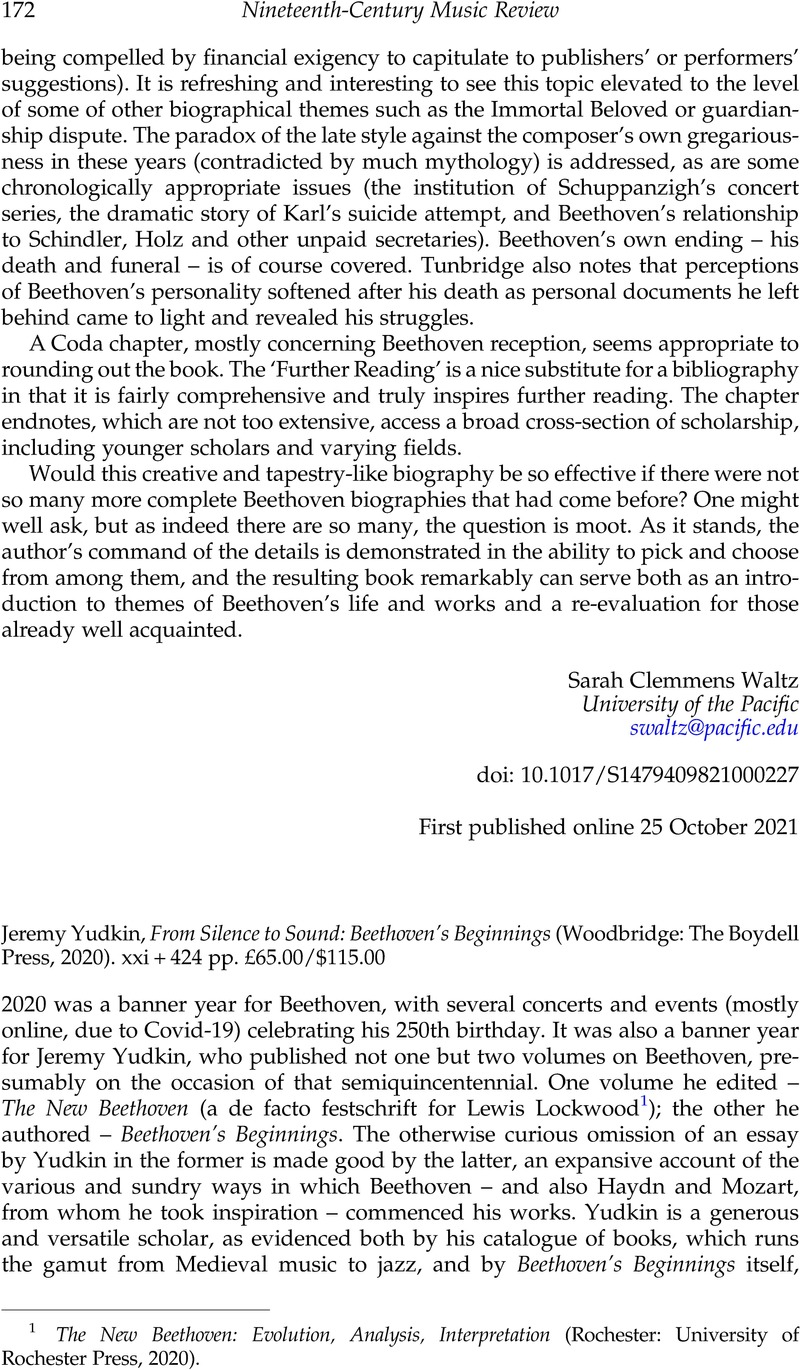No CrossRef data available.
Article contents
Jeremy Yudkin, From Silence to Sound: Beethoven's Beginnings (Woodbridge: The Boydell Press, 2020). xxi + 424 pp. £65.00/$115.00
Published online by Cambridge University Press: 19 October 2021
Abstract

- Type
- Book Review
- Information
- Copyright
- Copyright © The Author(s), 2021. Published by Cambridge University Press
References
1 The New Beethoven: Evolution, Analysis, Interpretation (Rochester: University of Rochester Press, 2020).
2 Yudkin usefully enumerates many of the items in Beethoven's library (p. 27), the breadth of which points to Beethoven's voracious intellectual appetite.
3 William E. Caplin, Classical Form: A Theory of Formal Functions for the Instrumental Music of Haydn, Mozart, and Beethoven (New York: Oxford University Press, 1998).
4 I refer to first movements unless otherwise stated.
5 Levy, Janet, ‘Texture as a Sign in Classic and Early Romantic Music’, Journal of the American Musicological Society 35/3 (1982): 489CrossRefGoogle Scholar.
6 In her review of this book, M. Lucy Turner also raised this concern, in particular with respect to Beethoven's String Quartet in F Major, Op. 18, No. 1, which Yudkin invokes around a dozen times. See Eighteenth-Century Music 18/1 (2021): 202–4.
7 To be sure, there is some disagreement about what precisely constitutes a genuine cadence. William Rothstein, for one, avers that a cadence is what ends a phrase – or, put the other way around, that a phrase is ‘a constant movement toward a goal – a cadence’ (Phrase Rhythm in Tonal Music (New York: Schirmer Books 1990), p. 4). William Caplin, for another, demurs at conflating cadences and phrase endings; in his view, phrases can, but need not, be punctuated by cadences (‘The Classical Cadence: Conceptions and Misconceptions’, Journal of the American Musicological Society 57/1 (2014): 51–117). Such divergence notwithstanding, these authors, and most others, abide by certain basic restrictions, especially as to harmonic content. Yudkin does not, as I go on to explain.
8 ‘beyde sind auf einer wirklich gantz neuen Manier bearbeitet, jedes auf eine andere verschiedene Art’ (Beethoven's emphases; this and all translations are mine). This letter, which dates from 18 October 1802, can be found in Beethovens Sämtliche Briefe, Volume 1, ed. Alfred Christlieb Kalischer (Berlin: Schuster and Loeffler, 1906): 98.
9 ‘der Werkeinheit ausdrücklich und in individuellem Zugriff hergestellt, nicht in einem fertig Gegebenen (Variationsthema) . . . Vorgeformten vorausgesetzt wird’. Kunze, Stefan, ‘Die “wirklich gantz neue Manier” in Beethovens Eroica-Variationen op. 35’, Archiv für Musikwissenschaft 29 (1972): 147CrossRefGoogle Scholar.
10 Theodor W. Adorno, Beethoven: The Philosophy of Music (Fragments and Texts), ed. Rolf Tiedemann, trans. Edmund Jephcott (Stanford: Stanford University Press, 1988): 13.
11 Adorno, Beethoven, 14.
12 See especially Chapter 2 of Janet Schmalfeldt, In the Process of Becoming: Analytic and Philosophical Perspectives on Form in Early Nineteenth-Century Music (New York: Oxford University Press, 2011).
13 Carl Dahlhaus, Ludwig van Beethoven: Approaches to his Music, trans. Mary Whittall (Oxford: Clarendon Press): 170–71.
14 ‘der Eingang von diesen großen Variationen . . . mit dem Baß des themas anfängt, dann zu 2 zu 3 und zu vier Stimmen endlich wird und dann erst das thema kömmt’. This letter, which dates from 8 April 1802, can be found in Beethovens Sämtliche Briefe, Volume 1, 112. Kunze glosses Beethoven's point thus: ‘the theme is put forward not as something ready-made but as built from scratch’ [Das Thema wird nicht als ein Fertiges aufgestellt, sondern von Grund auf erbaut]. ‘Die “wirklich gantz neue Manier” in Beethovens Eroica-Variationen op. 35’, 131.
15 For a fuller explanation of this phenomenon, consult Swinkin, Jeffrey, ‘Variation as Thematic Actualisation: The Case of Brahms's Opus 9’, Music Analysis 31/1 (2012): 37–89CrossRefGoogle Scholar.





